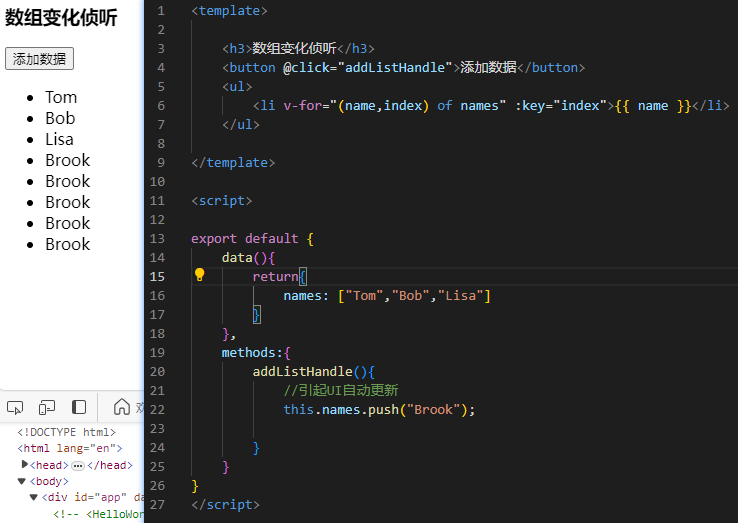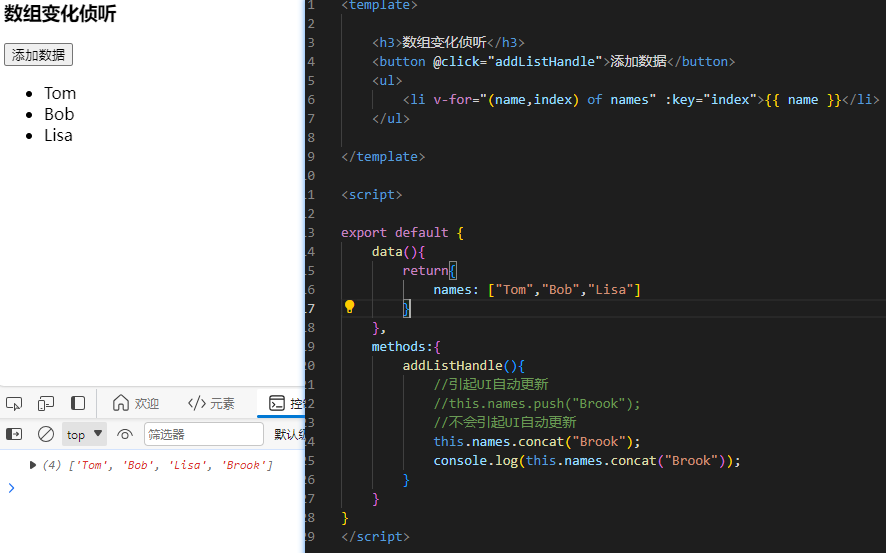文章目录 1.数组变化的侦测 2.计算属性 3.Class绑定 3.1.绑定对象 3.2.多个对象的绑定形式 3.3.绑定数组 3.4.数组与对象
vue能够侦听响应式数组的变更方法,并在它们被调用时出发相关的更新。这些变更方法包括:
push ( )
pop ( )
shift ( )
unshift ( )
splice ( )
sort ( )
reverse ( )
变更方法,就是会对调用它们的原数组进行变更。相对的,也有一些不可变的方法,例如:
filter ( ) concat ( ) slice ( )
这些不会更改原数组,而总是返回一个新数组,当遇到的是非变更方法时,我们需要将旧的数组替换为新的
this . names = this . names. concat ( "Brook" ) ;
< template> < h3> 数组变化侦听< / h3> < button @click= "addListHandle" > 添加数据< / button> < ul> < li v- for = "(name,index) of names" : key= "index" > { { name } } < / li> < / ul> < button @click= "concatHandle" > 合并数组< / button> < h3> 数组1 < / h3> < p v- for = "(num,index) of num1" : key= "index" > { { num } } < / p> < h3> 数组2 < / h3> < p v- for = "(num,index) of num2" : key= "index" > { { num } } < / p> < / template> < script> export default { data ( ) { return { names : [ "Tom" , "Bob" , "Lisa" ] , num1 : [ 1 , 2 , 3 , 4 , 5 ] , num2 : [ 6 , 7 , 8 , 9 , 10 ] } } , methods : { addListHandle ( ) { this . names = this . names. concat ( "Brook" ) ; } , concatHandle ( ) { this . num1 = this . num1. concat ( this . num2) ; } }
}
< / script>
模板中的表达式虽然方便,但也只能用来做简单的操作,如果在模板中写太多的逻辑,会让模板变得臃肿,难以维护。
因此我们推荐使用计算属性来描述依赖响应式状态的复杂逻辑
< template> < h3> { { person. name } } < / h3> < p> { { person. content. length > 0 ? "yes" : "no" } } < / p>
< / template> < script> export default { data ( ) { return { person : { name : "张三" , content : [ "软件工程" , "Java" , "互联网与应用技术" ] } } }
}
< / script> 改造后< template> < h3> { { person. name } } < / h3> < p> { { personContent } } < / p> < p> { { personContent1 ( ) } } < / p>
< / template> < script> export default { data ( ) { return { person : { name : "张三" , content : [ "软件工程" , "Java" , "互联网与应用技术" ] } } } , computed : { personContent ( ) { return this . person. content. length > 0 ? "yes" : "no" } } , methods : { personContent1 ( ) { return this . person. content. length > 0 ? "yes" : "no" } }
}
< / script>
以上代码可以看出,计算属性和方法都能实现,那么为什么要使用计算属性:
计算属性:计算属性值会基于其响应式依赖被缓存。一个计算属性仅会在其响应式依赖更新时才会重新计算
(只要代码不变,只执行一次,多次调用的值也只执行一次)
方法:方法调用总是会在重渲染发生时再次执行函数
(方法调用几次,执行几次)
数据绑定的一个常见需求场景是操纵元素的 CSS class 列表,因为class 是attribute,我们可以和其他attribute一样使用v- bind将它们和动态字符串绑定。
但是,在处理比较复杂的绑定时,通过拼接生成字符串是麻烦且容易出错的。
因此,Vue专门为class 的v- bind用法提供了特殊的功能增强。除了字符串外,表达式的值也可以是对象或数组
< template> < h3> Class样式< / h3> < p : class = "myClass" > Class样式绑定< / p>
< / template> < script> export default { data ( ) { return { myClass : "Demo" } }
}
< / script>
< template> < h3> Class样式< / h3> < p : class = "{ 'active':isActive,'text-danger':hasError }" > Class样式绑定< / p>
< / template> < script> export default { data ( ) { return { isActive : true , hasError : true } }
}
< / script> < style>
. active{ font- size: 30px;
}
. text- danger{ color : red;
} < / style>
< template> < h3> Class样式< / h3> < p : class = "ClassObject" > Class样式绑定< / p>
< / template> < script> export default { data ( ) { return { ClassObject : { active : true , 'text-danger' : true } } }
}
< / script> < style>
. active{ font- size: 30px;
}
. text- danger{ color : red;
} < / style>
< template> < h3> Class样式< / h3> < p : class = "[arrActive,arrTextDanger]" > Class样式绑定3 < / p>
< / template> < script> export default { data ( ) { return { arrActive : 'active' , arrTextDanger : 'text-danger' } }
}
< / script> < style>
. active{ font- size: 30px;
}
. text- danger{ color : red;
} < / style>
如果想在数组中有条件地渲染某个class ,也可以使用三元运算符
< template> < h3> Class样式< / h3> < p : class = "[isActive ? 'active' : '']" > Class样式绑定4 < / p>
< / template> < script> export default { data ( ) { return { isActive : true } }
}
< / script> < style>
. active{ font- size: 30px;
}
. text- danger{ color : red;
} < / style>
数组和对象嵌套过程中,只能是数组嵌套对象。[ { } , { } ]
< template> < h3> Class样式< / h3> < p : class = "[{'active':isActive},arrTextDanger]" > Class样式绑定5 < / p> < p : class = "[isActive ? 'active' : '',{'text-danger':hasError}]" > Class样式绑定6 < / p>
< / template> < script> export default { data ( ) { return { isActive : true , hasError : true , arrActive : 'active' , arrTextDanger : 'text-danger' } }
}
< / script> < style>
. active{ font- size: 30px;
}
. text- danger{ color : red;
} < / style>


